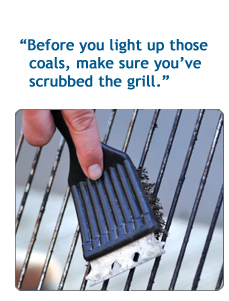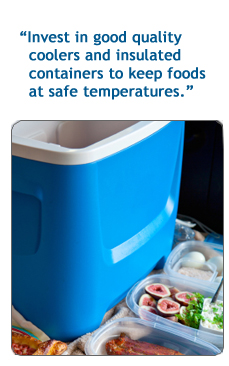 Did someone say "let’s grill out tonight?" Why not!
The summer days of scrumptious barbecues and relaxing-in-nature picnics are here. However they can come with an unappetizing and downright sickening downside.
According to the U.S. Department of Agriculture’s Food Safety and Inspection Service (FSIS), food-borne illnesses increase during the summer. Fortunately, by getting the facts on summer food safety you can take precautions to make sure nothing spoils your outdoor feasts.
Hot weather food dangersFSIS experts say most illness-causing bacteria found in food grow fastest in warm temperatures and moist environments. So, given the right circumstances such as a dish of potato salad left out too long on a picnic table on a hot and humid day, these microorganisms multiply in food extremely quickly. For people who eat food contaminated this way, the result can range from a mild tummy upset to serious food poisoning.
The FSIS also points out another problem with summer eat-outs. When you cook and/or dine outdoors at barbecues, picnics and on camping trips, you simply don’t have the same safety controls found in your home kitchen – like a sink for washing, refrigeration, and thermostat-controlled cooking.
However, with some preparation and planning, you can solve these potential problems. Here’s how to serve up savory – and safe – outdoor dishes this summer.
 Keep it cleanBefore you light up those coals, make sure you’ve scrubbed the grill thoroughly. Wash all outdoor utensils, food containers, and even coolers in hot, soapy water, before and after using, advises the American Dietetic Association (ADA).
Wash your hands thoroughly in warm, soapy water for at least 20 seconds after handling food, too. If that’s impossible in an outdoor setting, keep a bottle of hand sanitizer near your grill and moist towelettes around for those times soap and water are not available.
When packing your cooler for an outing, make sure any raw meat is wrapped securely so no meat juices come in contact other already cooked and prepared foods.
You don’t have to worry about cooking melons and they grow outside in warm weather, so they must be safe choices for picnics on warm summer days, right? Not necessarily.
Food safety experts from the University of Nebraska Cooperative Extension service explain that while only the insides of fruits like watermelons and cantaloupes are eaten, it’s important to wash the outer rind of the fruit thoroughly.
That’s because bacteria present in soil can contaminate the skin of the melon. Then, when the melon is sliced open at your picnic, the germs can be transferred to the part you eat and grow to levels that cause foodborne illness.
 Tips for preparing food safely outdoors- Cross-contamination with bacteria is a major food safety concern during the outdoor grilling season. The ADA warns to never use the same plates and utensils to handle raw foods and cooked foods. Likewise, don’t use the same brush to baste both raw and cooked meats.
- You may have learned that meat is done because juices run clear or it feels firm – but the ADA says that’s not a safe conclusion. A food thermometer is the only accurate way to make sure food has been cooked to the proper temperature.
- Visit www.homefoodsafety.org for the ADA’s free, downloadable chart of safe minimum internal temperatures for barbecue favorites.
- If the meat you’ll be grilling later on in the day is frozen, defrost it at home in the refrigerator or in the microwave – never outside at a picnic or tailgate party where too warm temperatures spur bacteria growth.
Summer food storage on-the-goIt sounds simple enough – keep cold foods cold and hot foods hot. However the key is to keep them in the right temperature range.
For example, bacteria thrive best between 40 and 140 degrees Fahrenheit. So cold foods such as picnic favorites like potato salad and deviled eggs need to be stored at or below 40 degrees from the time these dishes are prepared to when they’re served. Hot foods, including side dishes like mashed potatoes, need to be kept at around 140 degrees ready to be eaten.
The solution? Invest in good quality coolers and insulated containers to keep foods at safe temperatures from the time they are prepared until mealtime.
It’s not enough to stock coolers with lots of ice and/or ice packs, according to the ADA. Add a refrigerator thermometer, too, to make sure foods are stored below the 40 degrees Fahrenheit.
Never allow foods that can spoil to be unrefrigerated for more than two hours, or one hour in hot weather (90 degrees Fahrenheit or above). Use the alarm on your cell phone to remind you when food should be put back in the cooler.
If you’ll be on the road for a while heading to your cook-out destination, consider packing canned beverages in one cooler and perishable foods in another. The drink cooler will probably be opened frequently, so the food cooler can be kept closed – and colder. Placing the cooler in the shade whenever possible is a smart idea for keeping foods as cold as possible, too.
If taking a cooler isn’t an option, remember there are plenty of summer goodies that aren’t perishable, need no cooking, and make great picnic fare. For example, pack fresh fruits like grapes and apples, raw veggies (including carrots and celery sticks), hard cheeses, canned or dried meats, crusty bread or crackers, nuts and beverages and you have a delicious and safe hot weather meal.
The FSIS offers this bottom line on outdoor eating this summer: if you have any reason to think food has been kept out in the heat too long or wasn’t prepared safely, just skip it. Simply put, if there’s any doubt – throw it out!
|